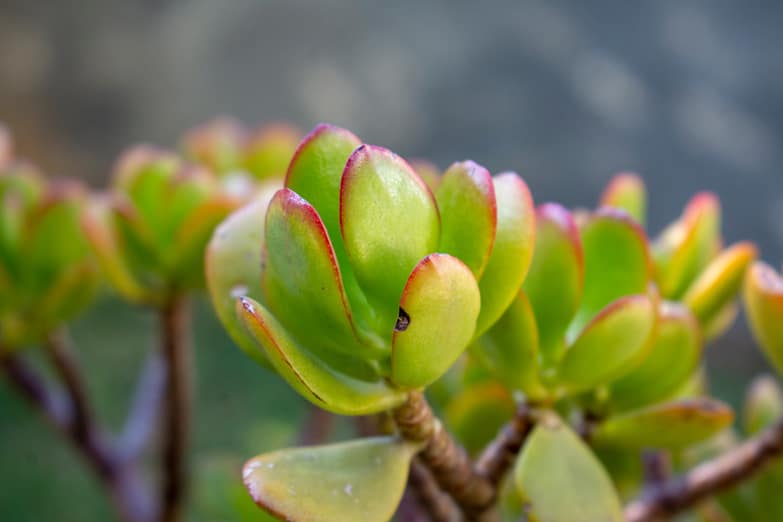Jade plants are one of the most popular indoor plants for very good reasons. They are extremely versatile, great looking and it generally doesn’t take much to keep them happy. However, If you’ve found your Jade plant leaves turning yellow, you’re not alone. Thankfully, this article will help you identify the cause, fix it and learn to prevent the problems that cause yellow leaves.
Why are my jade plant leaves turning yellow? Overwatering is the most common cause. Other causes include underwatering, excessive fertilizer, pests, disease, light problems or temperature stress. Some leaves naturally turn yellow with age, and some Jade plant cultivars have naturally yellow leaves.
Keep reading to learn how to identify why the leaves on your Jade plant (Crassula ovata) are turning yellow, how to fix each issue and how to keep your Jade plant looking green and healthy year after year.
Causes Of Jade Plant Leaves Turning Yellow
The first thing we’re going to talk about is overwatering, which is the most common reason that jade leaves turn yellow. After that, we’ll get into the other reasons you might see this problem and how to fix them, so you can have your jade plant looking fresh again!
Overwatering
Overwatering is the most common cause of yellow leaves on jade plants. Their relatively low water requirements, combined with many gardeners being a little too enthusiastic with the watering can often lead to overwatering. This is a common problem with indoor plants, but Jade plants are particularly poor at handling excessive water. See this article about Jade plant overwatering for more detail.
Some people like to follow a watering schedule for their succulents but this usually isn’t the best approach. So many factors impact the amount of water that an individual plant needs, that you are better assessing your plant and the soil before deciding if it needs watered.
As a general rule, you should water your jade plant once the soil has almost completely dried out. When you can no longer feel moisture with your hand, it is time to water. This way, you ensure that you water your plant only when it needs it, as opposed to using an arbitrary schedule.
When your Jade plant sits in continually wet, soggy soil, the roots will initially absorb excess water and the leaves can swell and become edematous. However, the roots will be unable to access enough oxygen, becoming stressed, before developing root rot, and dying. Without access to water and nutrients, the leaves will slowly turn yellow, often affecting lower leaves first.
Look for generalized yellowing, with associated soggy, poorly draining soil to confirm overwatering as the cause. Read how to fix an overwatered plant for practical steps to fix this issue. If root rot has developed, read this article as you will need to take emergency steps to save your plant.
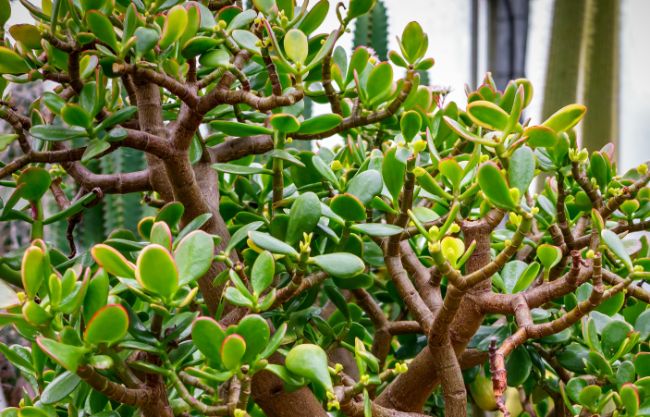
Underwatering
Jade Plants are much more capable of surviving drought than a flood, but they do still need some water. If your jade plant hasn’t been watered in a long while and the soil is bone dry, then chances are underwatering is the cause of yellow leaves on your Jade Plant.
When your jade plant begins to dry out, the leaves of the plant may start to shrivel and droop. Older foliage, as well as tender new growth, will turn brown or yellow and may have crispy tips or edges. In contrast, a healthy jade plant has smooth, green leaves.
Jade plants do not require a lot of water but they will dry out if you leave it long enough. Remember, water your jade plant when the soil is just about dry, but don’t leave it sitting for too long after this.
I like to feel the soil through the bottom drainage holes to see if the soil is dry right to the bottom before watering. Here are some other great tips to help you tell when to water your indoor plants.
Excessive Fertilizer
Jade plants don’t need a lot of fertilizer, but they will benefit greatly from having a little. The problem is that a little goes a long way, and it’s really easy to add too much.
Excessive fertilizer is toxic to the roots and impacts the pH of the soil. Initially, this results in excessive absorption of some nutrients, and a relative deficiency of others. With progressive root damage, you’ll soon find your jade plant leaves turning yellow due to the roots dying and being unable to absorb essential water and nutrients that the plant needs.
If you have been fertilizing your Jade plant more than once per month, particularly using a full-strength fertilizer, consider nutrient toxicity as being a likely cause of your jade plant leaves turning yellow.
Examine your Jade Plant for other clues such as small white spots on the leaves at regular intervals, which are often mineral deposition as a result of transpiration from the stomata. You may also see white fertilizer salt deposits in the soil.
Stop fertilizing for at least 3 months and thoroughly flush the soil with water to remove excess fertilizer salts. Don’t fertilize your plant again until it has fully recovered. Apply a water-soluble fertilizer at half strength every 1-2 months during the growing season, and hold off fertilizing during winter to prevent further yellow leaves on your Jade Plant. Read my guide to fertilizing houseplants for more information.
Nutrient Deficiency
Although less common, Jade plants can also develop nutrient deficiency. This is more likely to occur to your Jade plant if it has been in the same pot for several years, in an infertile medium, and has not been fertilized in a long time.
You may be wondering why your plant looks sparse and unhealthy and many of your Jade plant leaves are becoming pale and yellow, despite getting adequate water and light.
The way to test this theory is to fertilize your plant and wait a few weeks. The addition of a little fertilizer should trigger a burst of growth and improvement in the color of the leaves. If you get the desired response, just remember to provide a little fertilizer from time to time.
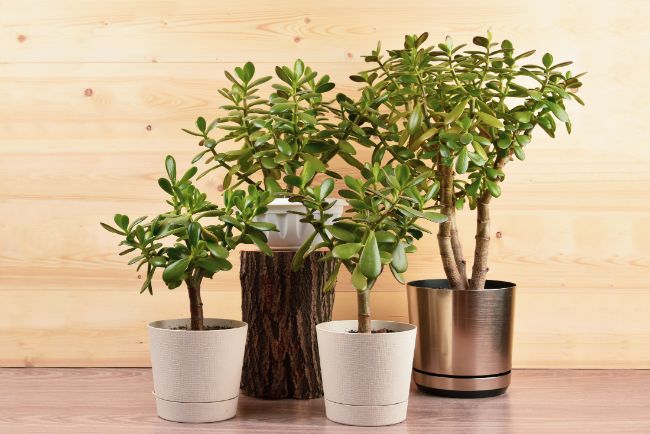
Temperature Stress
Jade plants thrive in warm temperatures of 65-86°F (18-30°C), but can handle temperatures outside this range, particularly if they are introduced to the changes slowly.
However, a sudden change in temperature, down to below 40°F (4°C), or intermittent hot or cold drafts will result in considerable stress to the plant. The first sign of this is likely to be jade plant leaf yellowing, leading to leaf drop.
Consider where you have positioned your Jade plant. Is it near a hot or cold heating vent or radiator, or is it sitting next to a drafty window in winter? Move your Jade plant to a more appropriate spot and ensure all the other care needs are being met. It may take a while for your Jade plant to bounce back, but they are resilient plants, so don’t give up.
Poor Light
Jade plants love bright sunlight, which is something many of our homes are not wonderful at providing. Jade plants do acclimatize to lower light levels indoors, but in a dark corner, or north-facing room, light levels may just be too low to sustain healthy foliage.
Your Jade plant will initially respond to low light levels by boosting the amount of chlorophyll in the leaves, making them appear darker and more vibrantly green. This can sometimes improve the look of your plant but is an early warning sign. Eventually, the leaves on your jade plant will start to turn yellow as the plant struggles to sustain all the foliage in the given amount of light.
Jade plants do best with a mix of direct and bright, indirect light. Constant direct light in the middle of summer might be a bit much, but a few hours of direct sunlight in an otherwise bright room would be ideal.
I’ve written two articles about lighting for houseplants which may help you get things just right for your Jade Plant. This one explains exactly what bright, indirect light means, and the other discusses how strong direct light through a window is compared to direct light outside.
Excessive Bright Light
The other side of the lighting coin is when you give your plant too much sun. Your Jade plant will struggle to tolerate long days of full sun in summer. It’s best to move it to somewhere it only gets a few hours of direct sun per day and spends the rest of the time in bright shade. I tend to pick east or west-facing windows for my Jade plants in summer and move them to a south-facing window in winter.
Jade plants respond to very bright light, or some other sources of stress, by developing red leaves, particularly at the edges. With persistent, excess light, the production of chlorophyll is reduced in favor of carotenoids, which help to protect the plant from light damage. These cause leaves to develop an increasingly yellow appearance.
With excess light, you can also expect some leaves, particularly those most exposed to the sun to become dehydrated, and may become brown or yellow secondary to this.
Jade plants are particularly at risk of getting yellow leaves from excess light if they are suddenly moved from a lower light area to a position in full sun. If you wish to move your jade plant to a brighter spot or put it outside for the summer, do it gradually so the plant has a chance to adjust.
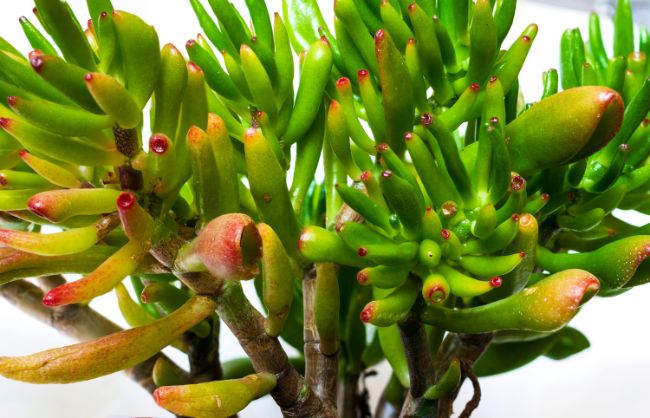
Transplant Stress
Repotting a plant is sometimes difficult. If done incorrectly, it can result in transplant stress or transplant shock which means the plant is having a difficult time thriving in its new environment. This can result in damage to the plant, particularly the roots.
This can result in your Jade plant leaves turning yellow due to root damage. The plant cannot sustain as much healthy foliage after suffering root damage, so leaf yellowing and leaf drop occur.
Jade plants grow slowly so they do not need to be repotted very often. Try to repot in spring, at the start of vigorous new growth, when the plant will be most capable of recovering quickly from the stress of repotting. Read more about how to repot indoor plants here.
Pests
Succulents are generally regarded as having a higher tolerance for pests but it does happen! A pest infestation can result in damage to the roots and leaves which can result in your jade plant leaves turning yellow.
The most common infestation in a jade plant is mealybugs. These look like white cotton-like masses on the leaves and stems of your jade plant. Mealybugs and other leaf-sucking pests love to feed on your plant by biting into the leaves and sucking the nutritious juices out. This causes yellow spots and irregular yellowing of Jade plant leaves.
Less common pests that might affect a Jade plant include spider mites, thrips, scale, or aphids. These are less common than mealybugs but can cause a similar pattern of leaf and plant damage.
Left untreated, your entire Jade plant will start to suffer and will develop generally yellow leaves. You should regularly check your Jade plant for bugs by carefully inspecting the foliage and treating it as soon as you spot anything. Remember to isolate any affected plant, to prevent the problem from spreading. In addition, I always isolate any new plants I bring home for at least a few days to ensure no unwanted hitchhikers are trying to invade my plant collection.
In terms of treatment, rubbing your Jade plant with isopropyl alcohol works well, as do applying horticulture oils or insecticidal soap. I’ve written a really helpful article about exactly how to identify, treat and prevent houseplant bugs, which you may find useful.
Disease
There is always the chance that the yellow leaves on your Jade plants are being caused by a disease or infection. Look for yellow or brown patches on your Jade plant leaves, evidence of root or crown rot, or extensive white deposits on the leaves.
Some of the more common diseases or infections that might infect a jade plant include bacterial soft rot, root rot, and powdery mildew. Many Jade plant diseases are caused by overwatering or excessively high humidity, so ensure that you’ve got these two aspects of care sorted.
Natural Leaf Aging
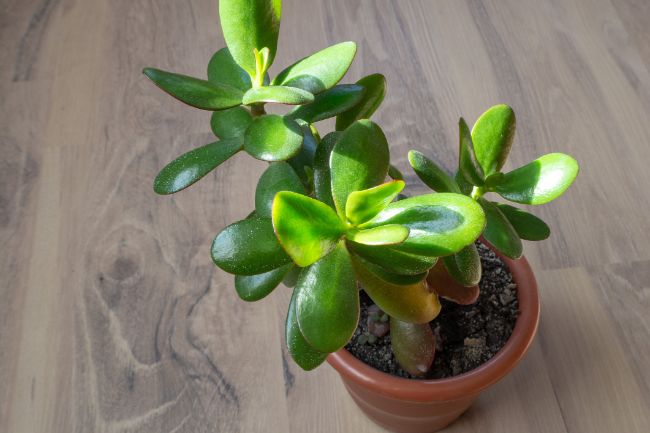
Sometimes, yellow leaves are simply due to natural leaf aging. Older jade plants will often develop yellow lower leaves, which will subsequently drop off. This is part of the natural growth habit of jade plants and will encourage them to develop a bare stem and more tree-like appearance as they get older.
This cause of Jade plant leaves turning yellow is only a cause for concern if all or most of the leaves are yellowing or if your jade plant is showing other signs of an issue.
Jade Plant Leaves Turning Yellow Can Be Intentional
Certain varieties of Jade plant are actually intended to have leaves which appear yellow. For example, the Crassula ovata “Hummel’s Sunset” naturally has yellow leaves. It is also known as the “Golden Jade Tree” for this very reason.
So, be sure to check into the specifics of the type of plant you actually have, it is possible that it’s supposed to be yellow!
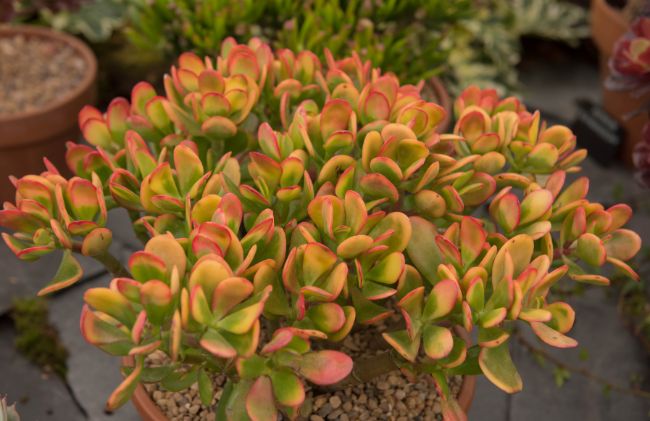
Conclusion: Why Is My Jade Plant Turning Yellow?
As you can see, there are many different reasons for Jade plant leaves turning yellow. The important thing is to examine your plant and the care conditions carefully to determine the correct cause. Once you know the cause, fixing your Jade plant should be a lot easier.
Bear in mind that the most common reason for Jade plant leaves turning yellow is overwatering. This makes up at least 50% of cases, so check your plant carefully. Only water your jade plant when the soil becomes dry to the touch. If this doesn’t solve the issue then you can look through the rest of the options above.
If you’d like to read more about Jade plant care and common problems, check out my other articles listed below.
- Why is my Jade plant dropping leaves?
- Symptoms and solutions for Jade plant overwatering.
- Why does my Jade plant have white spots?
- Why is my Jade plant turning red?
- Complete guide to growing Jade plants (Crassula ovata).
- Why is my Jade plant drooping?
- How to fix a leggy Jade plant.
- How fast do Jade plants grow?

